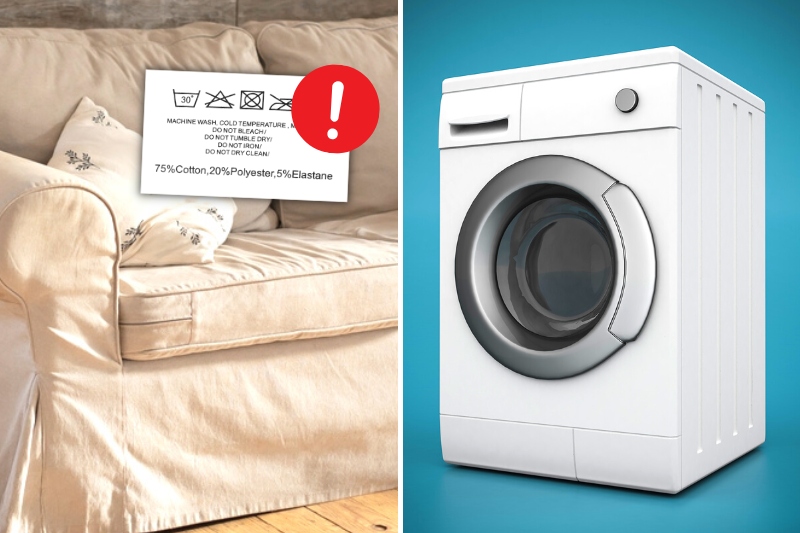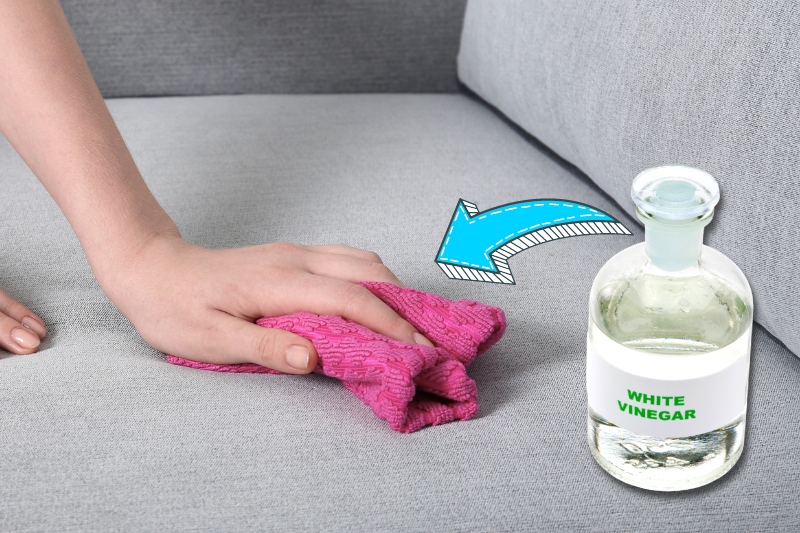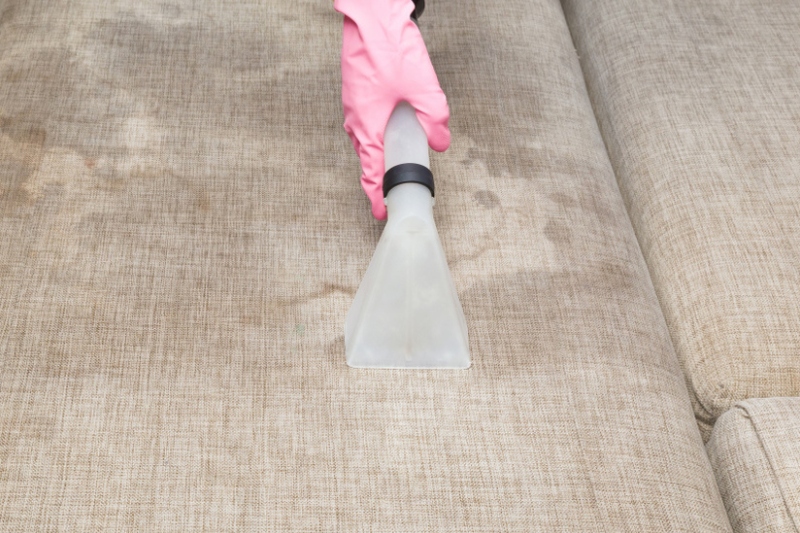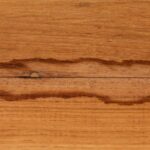It may seem impossible that water, which we use so often when cleaning, can leave stains. But it can stain glass, wood and fabric upholstery.
Water stains can be caused when there is dirt or minerals present in the water.
Since many of us are unaware of this, we tend to let water dry up on its own when it gets spilled. But this can encourage mould to grow and leave an unsightly mark.
In this article, we explain how water stains upholstery and how to clean it off when you have a fabric sofa.
There are different methods for removing water stains from your sofa. You can choose which method you follow based on which products you have to hand.
Before cleaning the stain, be sure to vacuum the sofa first.
Method 1: Washing Machine

If you are lucky enough to have a fabric sofa with removable covers, washing them in the washing machine is a great way to remove water stains.
First, check the care label on the covers to ensure they are machine washable.
If they are, follow the instructions carefully, selecting a gentle cycle and using cold water. It is also a good idea to use a mild detergent that is suitable for delicate fabrics.
Before washing the covers, make sure to brush off any loose dirt or debris, and pre-treat any particularly stubborn stains with a stain remover. It is important to note that some fabrics, such as silk or wool, may require special care or professional cleaning.
After washing, allow the covers to air dry or tumble dry on a low heat setting. Be sure to reattach the covers to the sofa only when they are completely dry.
If your sofa does not have removable covers or the care label does not allow for machine washing, do not attempt this method. Instead, try one of the other methods listed to remove water stains from your sofa.
Method 2: Vinegar

If your sofa’s covers aren’t removable, white vinegar can be a lifesaver.
Vinegar, a mild acid, is a great natural cleaner and stain remover that can help break down and lift water stains.
Here’s how to do it:
- Mix two cups of distilled water with half a cup of white vinegar. Make sure to use distilled water because tap water can have minerals that can cause staining or discoloration.
- Dip a clean cloth into the solution, making sure it’s damp, not wet. You don’t want to saturate the fabric as this can cause damage.
- Blot the stain gently, starting from the edge of the stain and working towards the centre. Avoid rubbing the stain as this can spread it and damage the fabric.
- Blot the area again using a dry cloth or kitchen towel to absorb excess moisture. If you have a hairdryer, use it on a low setting to help dry the area faster. Be sure to hold the hairdryer at least six inches away from the fabric to avoid damage.
- If the stain persists after the first attempt, you can repeat the process, and this time let the vinegar solution sit on the stain for about 20 minutes before blotting again. This will allow the vinegar to penetrate the stain more deeply and break it down further.
- After cleaning the stain, if you notice that the vinegar smell lingers, you can dampen a cloth with distilled water and blot the area before drying it again.
Note that vinegar is not safe for all types of fabrics, especially delicate or antique fabrics. Be sure to check the care label on your sofa or test a small, inconspicuous area before treating a water stain with vinegar.
Method 3: Steam Cleaning

Steam cleaning is an effective way to remove water stains from your fabric sofa, but you’ll need a steam cleaner for this method.
Before using a steam cleaner, make sure to check the sofa’s care label or manufacturer’s manual to ensure that the material can withstand high temperatures.
Most modern sofas are sturdy enough to undergo steam cleaning, but it’s better to be safe than sorry.
Here are the steps to follow for steam cleaning your fabric sofa:
- Vacuum the sofa thoroughly to remove any loose debris or dirt.
- Fill the steam cleaner with distilled water according to the manufacturer’s instructions. Do not add any cleaning solutions or detergents to the water as this may damage the fabric.
- Begin at one end of the sofa and work your way across, using the steam cleaner to apply hot steam to the surface of the fabric. Be sure to hold the nozzle of the steam cleaner a few inches away from the fabric to avoid damaging it.
- After steam cleaning the entire surface of the sofa, let it dry completely before using it again. This can take several hours, so be sure to plan accordingly.
Steam cleaning is an effective method for removing water stains and deep-cleaning your fabric sofa. It can also help to kill bacteria and allergens that may be lurking in the fabric.
However, if you’re unsure about using a steam cleaner on your sofa, or if the stain is particularly stubborn, it’s always best to consult a professional upholstery cleaner.
How to Treat Different Types of Fabric

Sofas can be made of various fabrics. Some popular options include cotton, linen, polyester, microfibre and velvet.
Removing water stains from these fabrics may need different approaches, depending on their unique properties.
Cotton
Cotton is known for its affordability and durability but is also prone to water stains.
To remove such stains, mix one tablespoon of washing up liquid with two cups of cool water, and use a clean cloth to blot the stain until it disappears.
Avoid hot water as it can make the stain worse.
Linen
Linen is a lightweight and breathable fabric commonly used for sofas, but it is sensitive to water and can easily develop water stains.
Mix equal parts of white vinegar and water, and use a clean cloth to blot the stain until it disappears. Rinse the area with cool water and let it air dry.
Polyester
Polyester is a synthetic fabric that is resistant to water stains. However, they can still appear over time.
Mix one tablespoon of ammonia with one cup of water, and use a clean cloth to blot the stain until it disappears. Rinse the area with cool water and let it air dry.
Microfibre
To remove water stains from microfibre, mix one tablespoon of rubbing alcohol with one cup of water, and use a clean cloth to blot the stain until it disappears. Let the area air dry, and then use a soft brush to restore the fabric’s texture.
Velvet
To remove water stains from velvet, mix equal parts of white vinegar and water, and use a clean cloth to gently blot the stain until it disappears. Use a soft-bristled brush to restore the fabric’s texture, and let it air dry.
FAQs on Water Stains
Can water stains be permanent?
The longer you leave a stain, the harder it will be to remove. That said, water stains will almost always come out.
Stains that have been left for a long time may need several treatments and a lot of effort to eliminate completely.
This is why it’s best to mop up water as soon as it comes into contact with your sofa or as soon as you notice a stain.
Does bicarbonate of soda remove water stains from upholstery?

Bicarbonate of soda alone probably won’t be able to remove a water stain from a fabric sofa. However, it can be used alongside vinegar for an extra boost.
Before trying the method using vinegar listed below, try sprinkling some bicarb on the water stain. Leave it for 20 minutes and then vacuum it up before cleaning.
The bicarb should lift the minerals that caused the stain and make the stain easier to remove.
Can old water stains be removed?
To remove older stains, you’ll need to use one of the above methods and repeat several times.
Repeating two to three times or combining different methods should be enough to get the stain out. However, if it won’t budge, you may want to contact a professional cleaner.

In The Wash is your guide to the best laundry and cleaning products, tips and tricks. Our mission is to solve the UK’s cleaning and laundry dilemmas!






